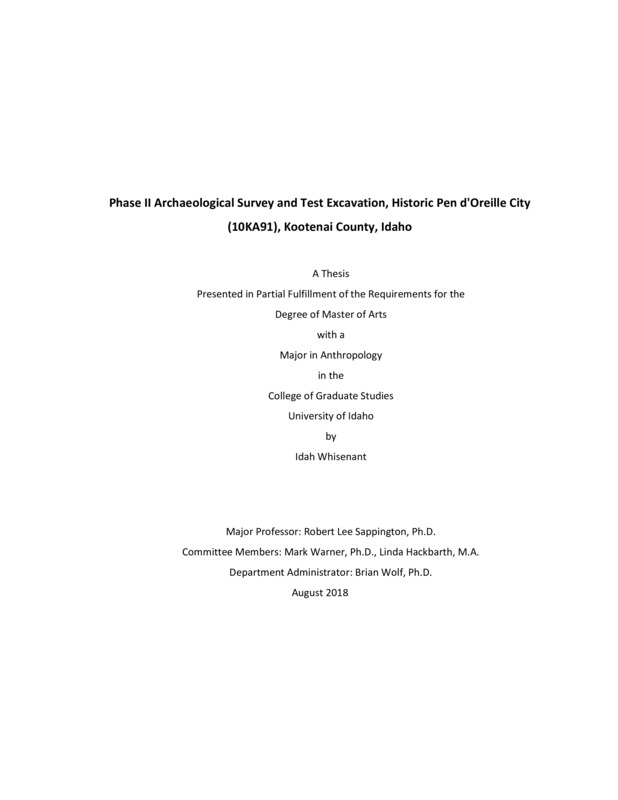Phase II Archaeological Survey and Test Excavation, Historic Pen d'Oreille City (10KA91), Kootenai County, Idaho
Whisenant, Idah M.. (2018-08). Phase II Archaeological Survey and Test Excavation, Historic Pen d'Oreille City (10KA91), Kootenai County, Idaho. Theses and Dissertations Collection, University of Idaho Library Digital Collections. https://www.lib.uidaho.edu/digital/etd/items/whisenant_idaho_0089n_11392.html
- Title:
- Phase II Archaeological Survey and Test Excavation, Historic Pen d'Oreille City (10KA91), Kootenai County, Idaho
- Author:
- Whisenant, Idah M.
- Date:
- 2018-08
- Keywords:
- Lake Pend Oreille North Idaho
- Program:
- Anthropology
- Subject Category:
- Archaeology; History
- Abstract:
-
Historic Pen d’Oreille City is located at the south end of Lake Pend Oreille in Farragut State Park. The 1866 settlement was associated with (1) transportation and gold rush themes followed by (2) a homestead and settlement period in the late 1800s to early 1900s and the cement industry on Lake Pend Oreille, (3) themes of World War II and (4) Farragut State Park in modern times.
The results of Phase II Pen d’Oreille City investigations are presented. The first phase of the project, a pedestrian surface survey and recording of the site, was completed in September 2015 by a University of Idaho archaeology team from the Alfred W. Bowers Laboratory of Anthropology for Kootenai County under a Certified Local Government (CLG) grant. The primary goals were to identify features and temporally associated artifacts, conduct historical research, and assess the site’s eligibility for nomination to the National Register of Historic Places (NRHP). Phase I results concluded that the Pen d’Oreille City (10KA91) is eligible for nomination to the NRHP and that further survey was suggested in the form of shovel test probes, targeted test excavation units, and ground penetrating radar (GPR).
Phase II of the CLG grant was to continue and expand intensive survey, resulting in expanded site boundaries and a larger artifact assemblage. Specific attention was given to cabins, public-use structure locations and features such as depressions, rock alignments, foundations, and roads/trails tentatively identified in 2015. Metal detection survey (MDS), two 50 x 50 cm sub-surface test units, feature recording, diagnostic artifact collection (451 collected and analyzed) and intensive survey, were completed in August 2017. The Phase II testing resulted in a clearer and expanded boundary based on artifact and feature distribution and historic maps.
Artifact assemblages, surface findings and subsurface testing indicate that the site occupants at various time participated in hunting, recreational activities, homesteading, cement making, blacksmithing, military training, and possibly logging. Cultural themes were identified from each period of the site. Surface artifact and sediment disturbance in areas combined with development projects and evidence of intense looting has greatly impacted the site. The investigation clarifies the potential for intact subsurface remains, the processes that disturbed the remains of Pen d’Oreille City, and how to proceed with future archaeological investigation.
- Description:
- masters, M.A., Anthropology -- University of Idaho - College of Graduate Studies, 2018-08
- Major Professor:
- Sappington, Robert Lee
- Committee:
- Warner, Mark; Hackbarth, Linda
- Defense Date:
- 2018-08
- Identifier:
- Whisenant_idaho_0089N_11392
- Type:
- Text
- Format Original:
- Format:
- application/pdf
- Rights:
- In Copyright - Educational Use Permitted. For more information, please contact University of Idaho Library Special Collections and Archives Department at libspec@uidaho.edu.
- Standardized Rights:
- http://rightsstatements.org/vocab/InC-EDU/1.0/

